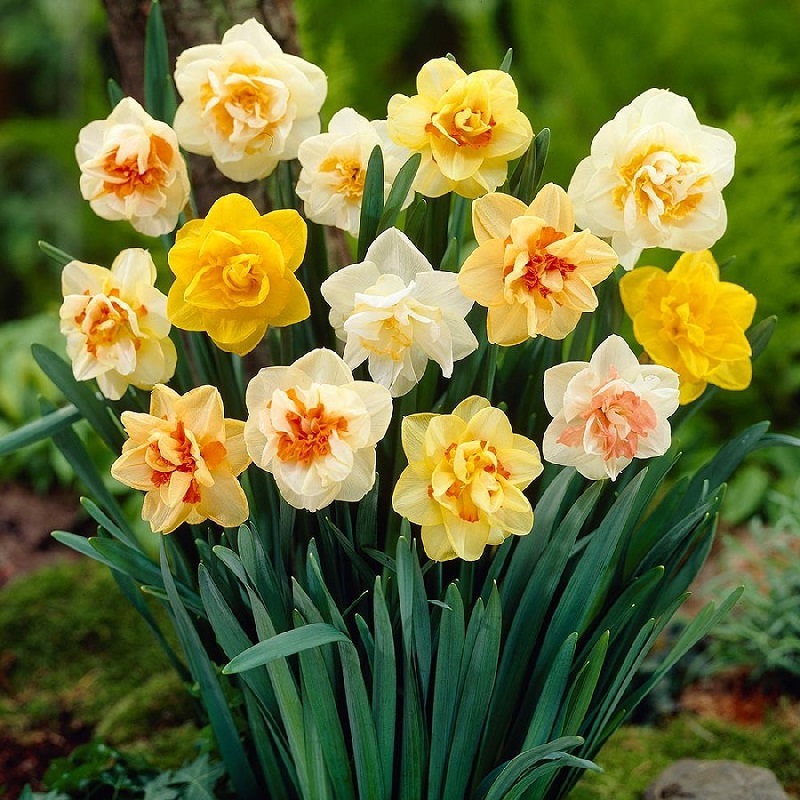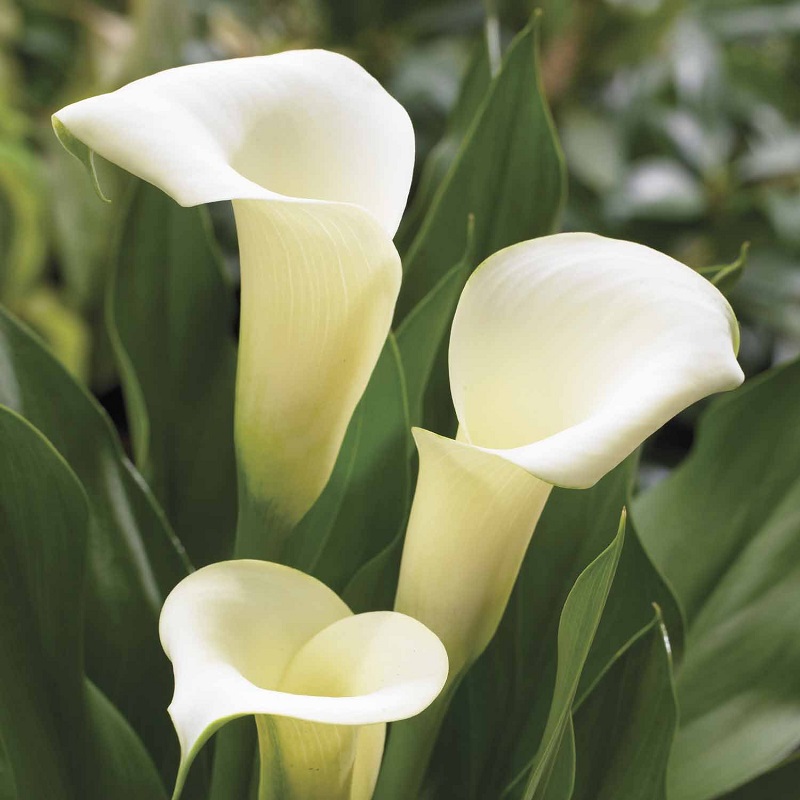
The most popular flower bulbs: how to grow them?
Many gardeners ask questions about flower bulbs and above all when planting them. The answer is not difficult to provide; in fact, flower bulbs such as tulips, daffodils, hyacinths. And many others are sown in autumn, they grow their roots in winter, then they sprout and bloom in spring.
Today between nature and hybrids there are several species of flower bulbs. And each produces beautiful specimens that are worth cultivating. Most are hardy and undemanding, and some can provide color year after year regardless of whether they are planted in pots or in an embankment. In all cases, these are specimens that deserve a place in every type of garden, be it classic or rocky.
Tulips flower bulbs
The tulips are precious bulbs, originating in Turkey rather large. And the petals are always a little narrowed creating the classic cupped. The petals (generally eight) are in one color, while in the inner part. And precisely next to the pistils they have a dark coloration that forms a very suggestive central eye. It is one of the most popular flower bulbs.
When and where to plant tulip bulbs
Tulip bulbs are planted in autumn due to the spring flowering that presents them erect. And with a single flower on a stem devoid of knots and leaves. Generally, before sowing, they are cooled in a fridge for at least 10 weeks.
The tulips grow best in full sun and partial shade in the north to the south, while with regard to the sowing must be inserted with the tip pointing upwards in well-drained soil with a pH between 6 and 7. To improve fertility, However, it is necessary to add sandy. And clay compost to help drainage the soil. Traditionally, tulips are planted at a depth of about 12-14 cm.
Irrigation and fertilization
To promote the growth of the root system before winter dormancy. It is necessary to avoid that the bulbs are too full of water after sowing. This care serves to prevent the roots from rotting or becoming ill. As for the fertilization, the bulbs during sowing in autumn. And again in the early spring, when the sprouts appear, need a specific organic fertilizer for flower bulbs.
The flower bulbs of hyacinths
The hyacinths belong to the family Asparagaceae, gardeners prefer them for their showy flowers, colorful and extremely flavorful. It is one of the most popular flower bulbs.
Among other things, it is easy to grow spring flower bulbs. And with careful preparation, it is even possible to make them flower in the house in time for Christmas. Whether you choose to plant them in a garden embankment. Or in containers to get the best from your hyacinths, it is necessary to read carefully the following description.
When and where to plant them
Covering the containers with the hyacinth bulbs inside. And putting them in a cold and dark place such as a cellar, a shed or a garage at a temperature of about 9 ° C is ideal for letting them rest for 10 weeks, checking them regularly and watering them sparingly if the compost looks rather dry.
Irrigation and fertilization
To create and obtain a constant flowering every year, it is advisable to work the soil with a little specific fertilizer for slow-release bulbs to be placed on the compost surface at the beginning of each spring. Of fundamental importance to optimize the growth of these flowers is to check. And water the compost to keep it moist but not excessively water impregnated.
You may also like- How to make wood floors less slippery
Saffron flower bulbs
To grow saffron flower bulbs, belonging to the Iridaceae family, one must first decide whether to plant them in containers or in the embankment. It is one of the most popular flower bulbs.
The flowers emitted from the saffron bulbs boast purple-colored petals with two anthers of the yellow shade. And three red-colored threads from which the spice is obtained after having dried them.
When and where to plant them
To plant the saffron bulbs in a container it is important to point out that in each there must be at least 10 cm of soil on the bottom, after which it is possible to bury them at about 6 cm from each other. This means that in a 60×20 cm box you can get at least 3 times 10 rows of the saffron bulb. After sowing the container must be covered with another 5-8 cm of soil. And on the surface with a specific compost for flower bulbs capable of supplying the saffron with the nourishment necessary to grow healthy and lush.
Irrigation and fertilization
Carefully watering each crate after finishing the stratification of the soil is very important; in fact, especially in the initial phase, the water regularly administered will help to start the period of active growth after the initial irrigation which must last a maximum of one week. In the following periods, you have to water the bulbs every 15 days. Because the saffron comes originally from a very dry and arid climate. These plants do not require much fertilization so just add fertilizer once a season. In fact, they are self-sufficient and do not require much time to grow.
Hyacinth bulbs in pots: how to cure them?
The daffodil flower bulbs
The daffodil flower bulbs are spring-flowering and perennial so they reproduce year after year. To cultivate the daffodils, belonging to the Amaryllidaceae family. And witness a luxuriant supply it is important to choose the right climate and adopt a series of measures.
The flowers are generally pure white and at the base have a decidedly wide spate. And have a green perigonium with an ovoid shape. In the central part is visible a yellowish crown which has serrated ends of a reddish shade. It is one of the most popular flower bulbs.
When and where to plant them
Daffodils to grow well love a bright place with at least 6 hours of sunshine each day. If planted in partial shade the plants will produce green leaves but will not bloom. Like most bulbs, the daffodils prefer the well-drained soil otherwise they are prone to rot and the best time to plant them is the autumn one. The soil, among other things, must be carefully prepared by mixing it with a specific compost for flower bulbs.
Irrigation and fertilization
Daffodils need a lot of water but only at the time of sowing; in fact, after about two weeks it is sufficient to irrigate them once every 7 days for the next 3 weeks. Usually, the spring rains provide a lot of moisture, but if your area does not foresee it for 2 or 3 weeks, then support watering is needed to make up for this lack of water. Finally, as far as fertilization is concerned, it must be said that good soil. And the right fertilizer is a perfect combination to obtain magnificent daffodils in the garden.
The flower bulbs of the amaryllis
If you are looking for a houseplant to flower in the winter to add a touch of color to your home, amaryllis, which as we can deduce from the botanical name belongs to the Amaryllidaceae family, is an excellent choice.
Famous for their tall stems and large, bold flowers, these specimens of flower bulbs can be enjoyed at any time from Christmas until spring. It is one of the most popular flower bulbs.
When and where to plant them
Planting the bulbs of the amaryllis it is possible to do it with a vase a little bigger than the bulb or covering two thirds. The soil must instead be of a generic compost. However, to keep it constantly moist and at the same time well-drained near the rim of the pot, it is advisable to add peat tablets or the shredded one. Being a tender plant, the amaryllis bulb needs to be kept at a constant temperature of 20-25 ° C before it can be inserted into the soil in order to promote growth. When the first leaves appear, they can then be planted in a pot (recommended) or in the embankment of a garden.
Irrigation and fertilization
As for the care of the amaryllis, the vase ready for spring flowering can be placed in a place where the sunlight is not too strong and water it rarely but without letting the soil dry completely. Once the leaves begin to die it is advisable to reduce the irrigation until the compost is not only moist, allowing the amaryllis bulbs to become dormant or semi-dormant.
The flower bulbs of the calla lilies
The flowering of the calla lilies, a bulb belonging to the Araceae family , is among the most romantic thanks to the soft and elegant lines of the tender semi-cones and because according to the language of flowers, if you receive them as a gift from your loved one, it means that they really love you. .
When and where to plant them
The street bulbs can be planted directly in the soil in late spring, or when the danger of frost has completely passed. Specifically, it is about inserting the rhizomes into the soil with about 4 centimeters of rich and moist soil.
Irrigation and fertilization of calla lilies
As for irrigation, it is essential when it comes to calla lilies; in fact, keeping them moist from the moment they are planted until they bloom and start dying is essential to prevent their early drying. For fertilizing instead of organic products enriched with plant-based fertilizer is the right option to maximize the result from the point of view of flowering.
The flower bulbs of anemones
One of the most captivating and productive spring flower bulbs is the anemone belonging to the Ranunculaceae family. It is, in fact, a specimen that blooms just three months after sowing. It is one of the most popular flower bulbs.
Among other things, these bulbs are easy to grow and bloom abundantly and with various shades of color during the spring, often producing up to 20 flowers per bulb, making them a real workhorse in the garden.
When and where to plant them
Depending on where you live, you can plant anemones in a vase either in autumn or late in winter or even in early spring. While the spring corms will not be as prolific as those planted in autumn, you can still have a nice harvest.
Irrigation and fertilization
During the growing period the anemones require watering twice a week and only when they have stabilized and when the flowers appear vigorously can one proceed with the regular ones. As far as fertilization is concerned, it is important to point out that in spring it is strongly recommended to use a nitrogen-based fertilizer but also rich in slow-release potassium.







